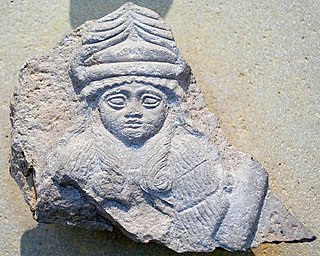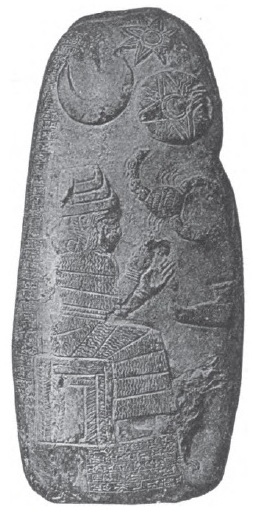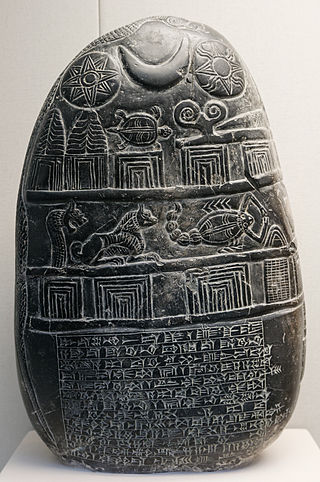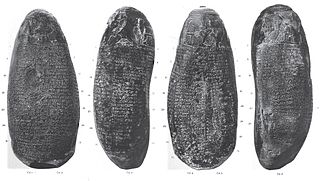Nintinugga was a Mesopotamian goddess associated with medicine and cleansing. She belonged to the local pantheon of Nippur. While she has been compared to other similar goddesses, such as Ninisina and Gula, and in a number of ancient texts they appear to be syncretised with each other or are treated as interchangeable, she was nonetheless a distinct deity in her own right. She was associated with Enlil and Ninlil, and was worshiped in their temples, though houses of worship dedicated only to her are also attested.

Bau (cuneiform: 𒀭𒁀𒌑 dBa-U2; also romanized as Baba or Babu) was a Mesopotamian goddess. The reading of her name is a subject of debate among researchers, though Bau is considered the conventional spelling today. While initially regarded simply as a life-giving deity, in some cases associated with the creation of mankind, over the course of the third and second millennia BCE she also acquired the role of a healing goddess. She could be described as a divine midwife. In art she could be depicted in the company of waterfowl or scorpions.

A kudurru was a type of stone document used as a boundary stone and as a record of land grants to vassals by the Kassites and later dynasties in ancient Babylonia between the 16th and 7th centuries BC. The original kudurru would typically be stored in a temple while the person granted the land would be given a clay copy to use to confirm legal ownership. Kudurrus are often linked to what are usually called "ancient kudurrus", land grant stones from the third millennium which serve a similar purpose though the word kudurru did not emerge until the 2nd millennium.

Marduk-apla-iddina I, contemporarily written in cuneiform as 𒀭𒀫𒌓𒌉𒍑𒋧𒈾ᵈAMAR.UTU-IBILA-SUM-na and meaning in Akkadian: "Marduk has given an heir", was the 34th Kassite king of Babylon c. 1171–1159 BC. He was the son and successor of Meli-Shipak II, from whom he had previously received lands, as recorded on a kudurru, and he reigned for 13 years. His reign is contemporary with the Late Bronze Age collapse. He is sometime referred to as Merodach-Baladan I.
Damu was a Mesopotamian god. While originally regarded as a dying god connected to vegetation, similar to Dumuzi or Ningishzida, with time he acquired the traits of a god of healing. He was regarded as the son of the medicine goddess Ninisina, or of her equivalents such as Gula or Ninkarrak. It is unclear which city was originally associated with him, but he is best attested in association with the cult center of his mother, Isin.

Meli-Šipak II, or alternatively Melišiḫu in contemporary inscriptions, was the 33rd king of the Kassite or 3rd Dynasty of Babylon c. 1186–1172 BC and ruled for 15 years. Tablets with two of his year names, 4 and 10, were found at Ur. His reign marks the critical synchronization point in the chronology of the Ancient Near East.

Enlil-nādin-apli, "Enlil (is) giver of an heir," reigned c. 1099–1096 BC, was the 5th king of the 2nd dynasty of Isin, and the 4th dynasty of Babylon. He was the son and successor of Nabu-kudurri-usur and was toppled by a revolt led by his uncle, Marduk-nādin-aḫḫē.
Pabilsaĝ was a Mesopotamian god. Not much is known about his role in Mesopotamian religion, though it is known that he could be regarded as a bow-armed warrior deity, as a divine cadastral officer or a judge. He might have also been linked to healing, though this remains disputed. In his astral aspect, first attested in the Old Babylonian period, he was a divine representation of the constellation Sagittarius.
Gunura was a Mesopotamian goddess, best known as a daughter and member of the entourage of the medicine goddess Ninisina. She was also associated with other similar goddesses, Gula and Nintinugga. Her original cult center is unknown, though she was worshiped in Isin, Nippur, Ur, Babylon and Assur. She is attested in a number of laments, in which she mourns the death of her brother Damu, and in a narrative about a journey of her mother Ninisina to Nippur.

The Nazimaruttash kudurru stone is a boundary stone (kudurru) of Nazimaruttaš, a Kassite king of Babylon, c. 1307–1282 BC. It was found at Susa and is now displayed at the Louvre.

Eanna-shum-iddina was a governor in the Sealand Dynasty of Babylon in the middle of the second millennium BC. Sealand was the region of southern Iraq, of the Tigris-Euphrates-(Mesopotamia) along the coast. Eanna-shum-iddina is known to have made at least one Kudurru boundary stone.

The Kudurrus of Isin, king Marduk-nadin-ahhe, late 2nd millennium BC, c. 1099-1082 BC.

The Kudurru for Šitti-Marduk is a white limestone boundary stone (Kudurru) of Nebuchadrezzar I, a king of the 2nd Dynasty of Isin, c. the late 12th century BC. He is known to have made at least four kudurru boundary stones.

The Land grant to Marduk-apla-iddina kudurru is a grey limestone 0.7-meter tall ancient Mesopotamian narû or entitlement stele recording the gift of four tracts of cultivated land with settlements totaling 84 GUR 160 qa by Kassite king of Babylon, Meli-Šipak, to a person described as his servant named Marduk-apla-iddina, who may be his son and/or successor or alternatively another homonymous individual. The large size of the grant together with the generous freedom from all territorial obligations has led historians to assume he was the prince. There are thirty six kudurrus which are placed on the basis of art-history to Meli-Šipak's reign, of which eight are specifically identified by his name. This is the best preserved of all of them.

Ninkarrak was a goddess of medicine worshiped chiefly in northern Mesopotamia and Syria. It has been proposed that her name originates in either Akkadian or an unidentified substrate language possibly spoken in parts of modern Syria, rather than in Sumerian. It is presumed that inconsistent orthography reflects ancient scholarly attempts at making it more closely resemble Sumerian theonyms. The best attested temples dedicated to her existed in Sippar and in Terqa. Finds from excavations undertaken at the site of the latter were used as evidence in more precisely dating the history of the region. Further attestations are available from northern Mesopotamia, including the kingdom of Apum, Assyria, and the Diyala area, from various southern Mesopotamian cities such as Larsa, Nippur, and possibly Uruk, as well as from Ugarit and Emar. It is possible that references to "Ninkar" from the texts from Ebla and Nikarawa, attested in Luwian inscriptions from Carchemish, were about Ninkarrak.

The Land grant to Ḫunnubat-Nanaya kudurru is an ancient Mesopotamian entitlement narû recording the gift of forty GUR of uncultivated land and control over three settlements by Kassite king Meli-Šipak to his daughter and the provision of exemptions from service and taxation to villages in the region guaranteed with a sealed tablet given to her, presumably to make the land transfer more palatable to the local population. It was excavated by a French archaeological team under the auspices of Jacques de Morgan at the turn of the twentieth century at Susa where it was found with a duplicate. It had been taken as booty by Elamite king Šutruk-Naḫḫunte after his 1158 BC campaign that brought about the demise of the regime of Babylonian king Zababa-šuma-iddina, the penultimate monarch of the Kassite dynasty. It is significant in that it shows the king making a second bequest with land he purchased to provide for his beneficiary, contradicting the earlier view of Kassite feudalism, where all land belonged to the monarch.

The Land grant to Munnabittu kudurru is an elongated egg-shaped black limestone ancient Mesopotamian narû or entitlement stele (kudurru), 46.5 cm high and 20.5 cm wide, which details the reconfirmation of a gift of 30 GUR of land by Kassite king Marduk-apla-iddina I to his servant Munnabittu, son of Ṭābu-melû. It is significant because, in addition to portraying eighteen divine icons around its top, it lists forty-seven gods in its inscription, more than any other similar object.

The Kudurru of Kaštiliašu' is a fragment of an ancient Mesopotamian narû, or entitlement stele, recording the legal action taken by Kassite king Kaštiliašu IV over land originally granted by his forebear Kurigalzu II, son of Burna-Buriaš II to Uzub-Šiḫu or -Šipak in grateful recognition of his efforts in the war against Assyria under its king, Enlil-nirari. Along with the Tablet of Akaptaḫa, these are the only extant kudurrus from this king's short eight-year reign and were both recovered from Elamite Susa, where they had been taken in antiquity, during the French excavations under Jacques de Morgan at the end of the nineteenth century and now reside in the Musée du Louvre.

Gula was a Mesopotamian goddess of medicine, portrayed as a divine physician and midwife. Over the course of the second and first millennia BCE, she became one of the main deities of the Mesopotamian pantheon, and eventually started to be viewed as the second highest ranked goddess after Ishtar. She was associated with dogs, and could be depicted alongside these animals, for example on kudurru, and receive figurines representing them as votive offerings.














